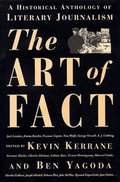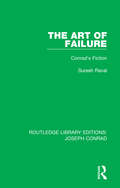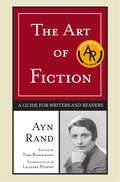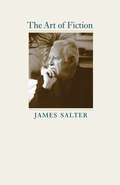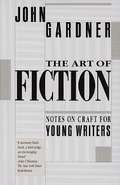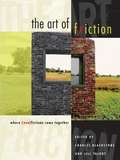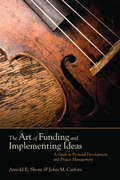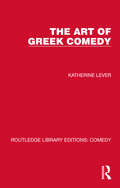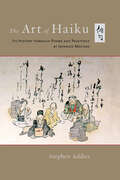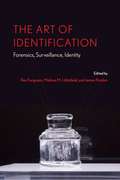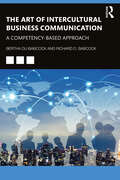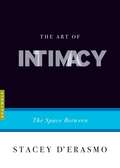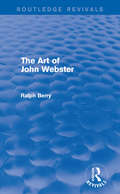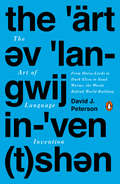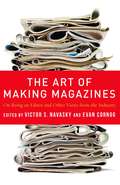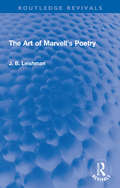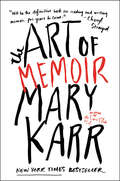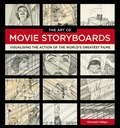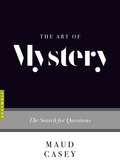- Table View
- List View
The Art of Fact: A Historical Anthology of Literary Journalism
by Ben Yagoda Kevin KerraneHistorical and international in scope, a unique anthology traces the course of literary journalism and nonfiction prose from its origins in the eighteenth century to today, from Daniel Defoe to Joseph Mitchell to Richard Ben Cramer.
The Art of Failure: Conrad's Fiction (Routledge Library Editions: Joseph Conrad #20)
by Suresh RavalOriginally published in 1986, this is a powerful and original book. It offers textual interpretation of Conrad’s major work and articulates the subtlety and richness of his treatment of social-political institutions and of the forces that complicate and distort private and public life. Suresh Raval argues that the social-personal relations in Conrad’s fiction cannot be conceived apart from their existence in the political life of a community; but at the same time they cannot be accommodated institutionally. The author’s concern is with the problematic status of the self under various perspectives: experience and understanding (Heart of Darkness), an ethical ideal (Lord Jim), history (Nostromo), ideology (The Secret Agent and Under Western Eyes), scepticism (Victory). What the self is remains ambiguous and elusive. Conrad’s fiction is concerned with exhibiting the failure of language, but always as a result of an immense effort of language itself. As language undoes itself in the act of seeking utterance, so Conrad’s fictional mode – romance – turns into the opposite of itself as it unfolds. Raval demonstrates that incompatible alternatives – intention and action, thought and experience, the individual and the social, the logical and the contingent – are entangled with each other, and how this entanglement works in the fiction. Raval’s exploration of Conrad’s scepticism shows why Conrad cannot be characterized as a political conservative or radical without distorting the complexity and seriousness of his reflection on society. For his scepticism is the product not just of intelligence but of intelligence conscious of its limitations, and is thus able to make a devastating critique of the nihilism sometimes attributed to Conrad by critics. Only those who think that morality has to have a secure single foundation if it is to be real are pushed into regarding Conrad’s scepticism as a form of nihilism. Professor Raval’s important study brings philosophical and literary interests to bear on Conrad’s major fiction and illuminates those aspects of his art which have puzzled and fascinated his readers. It will be deservedly valued by those studying and teaching modern literature.
The Art of Fiction
by Ayn RandIn The Art of Fiction, Ayn Rand, the legendary author of The Fountainhead and Atlas Shrugged, discusses how a writer combines abstract ideas with concrete action and description to achieve a unity of theme, plot, characterization, and style.
The Art of Fiction (Kapnick Lectures)
by James SalterJames Salter's exalted place in American letters is based largely on the intense admiration of other writers, but his work resonates far beyond the realm of fellow craftsmen, addressing themes--youth, war, erotic love, marriage, life abroad, friendship--that speak to us all.Following the publication of his first novel, Salter left behind a military career of great promise to write full-time and--through decades of searching, exacting work--became one of American literature's master stylists. Only months before he died, at the age of eighty-nine, he agreed to serve as the first Kapnick Writer-in-Residence at the University of Virginia, where he composed and delivered the three lectures presented in this book and introduced by his friend and fellow novelist, National Book Award-winning author John Casey. Salter speaks to us here with an easy intimacy, sharing his unceasing enchantment with the books that made up his reading life, including works by Balzac, Flaubert, Babel (whose prose is "like a handful of radium"), Dreiser, Céline, Faulkner. These talks provide an invaluable opportunity to see the way in which a great writer reads. They also offer a candid look at the writing life--the rejection letters, not one but two negative reviews in the New York Times for the same book, writing in the morning or at night and worrying about money during the long afternoons.Salter raises the question, Why does one write? For wealth? For admiration, or a sense of "importance"? Confronting a blank sheet that always offers too many choices, practicing a vocation that often demands one write instead of live, the answer for Salter was creating a style that captured experience, in a world where anything not written down fades away.Kapnick Foundation Distinguished Writer-in-Residence Lectures
The Art of Fiction: Notes on Craft for Young Writers
by John Gardner"John Gardner was famous for his generosity to young writers, and (this book) is his . . . gift to them. The Art of Fiction will fascinate anyone interested in how fiction gets put together. For the young writer, it will become a necessary handbook, a stern judge, an encouraging friend."--The New York Times Book Review.
The Art of Friction: Where [Non] Fictions Come Together
by Charles Jill Talbot Blackstone"We live in an Enquirer, reality television-addled world, a world in which most college students receive their news from the Daily Show and discourse via text message," assert Charles Blackstone and Jill Talbot. "Recently, two non-fiction writers have been criticized for falsifying memoirs. Oprah excoriated James Frey on her show; Nasdijj was impugned by Sherman Alexie in Time. Is our next trend in literature to lock down such boundaries among the literati? Or should we address the fictionalizing of non-fiction, the truth of fiction?" The Art of Friction surveys the borderlands where fiction and nonfiction intersect, commingle, and challenge genre lines. It anthologizes nineteen creative works by contemporary, award-winning writers including Junot Díaz, Jonathan Safran Foer, Thomas Beller, Bernard Cooper, Wendy McClure, and Terry Tempest Williams, who also provide companion pieces in which they comment on their work. These selections, which place short stories and personal essays (and hybrids of the two) side by side, allow readers to examine the similarities and differences between the genres, as well as explore the trends in genre overlap. Functioning as both a reader and a discussion of the craft of writing, The Art of Friction is a timely, essential book for all writers and readers who seek the truthfulness of lived experience through (non)fictions.
The Art of Funding and Implementing Ideas: A Guide to Proposal Development and Project Management
by Arnold R. Shore John M. CarforaTakes the reader to a new level in proposal writing "The authors have captured the gestalt of grant writing in a lucid fashion. In short, I think students would appreciate the clarity and insights this book offers."—Robert J. Hard, University of Texas at San Antonio "As a research scientist who is frequently involved in proposal development myself, it is clear to me that the authors have travelled the grant writer's path before." —John V. Stone, Michigan State University This resource provides a step-by-step approach to turning a research idea into a proposal worthy of funding, demystifying the process as a result. The authors present a proven approach to the development of research ideas alongside a systematic treatment of proposals section-by-section and project management function-by-function. Highly accessible, this book gives examples for each aspect of the proposal development and works through sketches of ideas to fully developed proposal sections. Key FeaturesContains idea development linked to specific proposal sections: Supports creativity that can be captured effectively and systematically one step at a time. Uses sketches to facilitate idea development and make enhancement and revisions easy: Allows for ease in trying out alternative formulations and revising preliminary approaches. Provides international research proposals: Key to understanding resources for proposing international research collaborations.Shows how to manage a funded project: Guides researchers and research staff in effectively implementing a funded project.This book is appropriate for all graduate students across the health, social, and behavioral sciences who need guidance on writing successful, compelling funding proposals.
The Art of Greek Comedy (Routledge Library Editions: Comedy)
by Katherine LeverOriginally published in 1956, this is a critical analysis of the comedies of Aristophanes and Menander studied in the context of the history of comedy, of the allied arts, and of contemporary life. Aristophanes and Menander are deservedly the most famous writers of Greek comedy. The extant comedies of Aristophanes are notable for wit, comical action, beautiful poetry, and the dramatization of such problems as health of mind and body, sex, money, government, law, religion, education, and drama, music and poetry. Menander portrays with delicate and sympathetic understanding a world in which the seeming evils of loss and discord eventually lead to the genuine goods of discovery and concord. The art of Aristophanes is critically examined in three chapters and that of Menander in one. For centuries Dionysos had been worshipped in a spirit of ecstasy which manifested itself in song, dance and the wearing of masks and costumes, pantomime, farce, and satire. The processes by which these diverse elements were developed and fused into the complex literary form of Old Comedy are the subject of the first three chapters. Aristophanes was not only pre-eminent as a writer of Old Comedy; he also participated in the transformation of Old Comedy into Middle Comedy, a curious and interesting dramatic form which is fully treated in the seventh chapter. In the last chapter the emergence of New Comedy is traced and the art of Menander criticized. The book ends with a brief indication of the various forms in which the spirit of Greek comedy had survived to the present day.
The Art of Haiku: Its History through Poems and Paintings by Japanese Masters
by Stephen AddissIn the past hundred years, haiku has gone far beyond its Japanese origins to become a worldwide phenomenon--with the classic poetic form growing and evolving as it has adapted to the needs of the whole range of languages and cultures that have embraced it. This proliferation of the joy of haiku is cause for celebration--but it can also compel us to go back to the beginning: to look at haiku's development during the centuries before it was known outside Japan. This in-depth study of haiku history begins with the great early masters of the form--like Basho, Buson, and Issa--and goes all the way to twentieth-century greats, like Santoka. It also focuses on an important aspect of traditional haiku that is less known in the West: haiku art. All the great haiku masters created paintings (called haiga) or calligraphy in connection with their poems, and the words and images were intended to be enjoyed together, enhancing each other, and each adding its own dimension to the reader's and viewer's understanding. Here one of the leading haiku scholars of the West takes us on a tour of haiku poetry's evolution, providing along the way a wealth of examples of the poetry and the art inspired by it.
The Art of History: A Study of Four Great Historians of the Eighteenth Century (Routledge Library Editions: Historiography #4)
by J. B. BlackThe first important scholarly consideration of Enlightenment historiography of the twentieth century, this book, originally published in 1926, critically examines the ideas of Voltaire, Hume, Robertston and Gibbon with respect to the theory and practice of historiography. The substantial introduction outlines the main differences between the ideals of these literary-philosophical schools and those which prevailed among historians in the early 20th century. The author argues that history can never be devoid of philosphical and literary interest, and that if it concerns itself merely with the stablishment of fact, will be a discipline of "contracting horizons".
The Art of History: Unlocking the Past in Fiction and Nonfiction (Art of...)
by Christopher BramOne has to look no further than the audiences hungry for the narratives served up by Downton Abbey or Wolf Hall to know that the lure of the past is as seductive as ever. But incorporating historical events and figures into a shapely narrative is no simple task. The acclaimed novelist Christopher Bram examines how writers as disparate as Gabriel García Márquez, David McCullough, Toni Morrison, Leo Tolstoy, and many others have employed history in their work.Unique among the "Art Of" series, The Art of History engages with both fiction and narrative nonfiction to reveal varied strategies of incorporating and dramatizing historical detail. Bram challenges popular notions about historical narratives as he examines both successful and flawed passages to illustrate how authors from different genres treat subjects that loom large in American history, such as slavery and the Civil War. And he delves deep into the reasons why War and Peace endures as a classic of historical fiction. Bram's keen insight and close reading of a wide array of authors make The Art of History an essential volume for any lover of historical narrative.
The Art of Identification: Forensics, Surveillance, Identity (AnthropoScene)
by Rex Ferguson, Melissa M. Littlefi eld and James PurdonSince the mid-nineteenth century, there has been a notable acceleration in the development of the techniques used to confirm identity. From fingerprints to photographs to DNA, we have been rapidly amassing novel means of identification, even as personal, individual identity remains a complex chimera. The Art of Identification examines how such processes are entangled within a wider sphere of cultural identity formation.Against the backdrop of an unstable modernity and the rapid rise and expansion of identificatory techniques, this volume makes the case that identity and identification are mutually imbricated and that our best understanding of both concepts and technologies comes through the interdisciplinary analysis of science, bureaucratic infrastructures, and cultural artifacts. With contributions from literary critics, cultural historians, scholars of film and new media, a forensic anthropologist, and a human bioarcheologist, this book reflects upon the relationship between the bureaucratic, scientific, and technologically determined techniques of identification and the cultural contexts of art, literature, and screen media. In doing so, it opens the interpretive possibilities surrounding identification and pushes us to think about it as existing within a range of cultural influences that complicate the precise formulation, meaning, and reception of the concept.In addition to the editors, the contributors to this volume include Dorothy Butchard, Patricia E. Chu, Jonathan Finn, Rebecca Gowland, Liv Hausken, Matt Houlbrook, Rob Lederer, Andrew Mangham, Victoria Stewart, and Tim Thompson.
The Art of Identification: Forensics, Surveillance, Identity (AnthropoScene: The SLSA Book Series #9)
by Rex Ferguson, Melissa M. Littlefi eld and James PurdonSince the mid-nineteenth century, there has been a notable acceleration in the development of the techniques used to confirm identity. From fingerprints to photographs to DNA, we have been rapidly amassing novel means of identification, even as personal, individual identity remains a complex chimera. The Art of Identification examines how such processes are entangled within a wider sphere of cultural identity formation.Against the backdrop of an unstable modernity and the rapid rise and expansion of identificatory techniques, this volume makes the case that identity and identification are mutually imbricated and that our best understanding of both concepts and technologies comes through the interdisciplinary analysis of science, bureaucratic infrastructures, and cultural artifacts. With contributions from literary critics, cultural historians, scholars of film and new media, a forensic anthropologist, and a human bioarcheologist, this book reflects upon the relationship between the bureaucratic, scientific, and technologically determined techniques of identification and the cultural contexts of art, literature, and screen media. In doing so, it opens the interpretive possibilities surrounding identification and pushes us to think about it as existing within a range of cultural influences that complicate the precise formulation, meaning, and reception of the concept.In addition to the editors, the contributors to this volume include Dorothy Butchard, Patricia E. Chu, Jonathan Finn, Rebecca Gowland, Liv Hausken, Matt Houlbrook, Rob Lederer, Andrew Mangham, Victoria Stewart, and Tim Thompson.
The Art of Intercultural Business Communication: A Competency-Based Approach
by Bertha Du-Babcock Richard D. D. BabcockThis book examines intercultural business communication issues and practices from a global and interdisciplinary perspective with an Asian focus, which is essential to any contemporary study on business communication. It broadens reader’s understanding of language, culture, and international business and equips them with intercultural business communication tools.The authors incorporate frameworks from business, management, and communication disciplines. The book comprises three parts. The first six chapters focus on developing theoretical frameworks and application for language, culture, and international business streams. Chapters 7 and 8 address the link-pin communication theories and practices. Link pin is the bilingual communicator standing between primary communicators and relaying messages back and forth in an interactive communication process. Chapter 9 discusses (intercultural) business communication in the digital age. The book concludes by revisiting and integrating universal theories to move toward global situational theories meeting this ever-changing intercultural environment. Approaching business communication from the individual, organizational, and industry levels, the book’s integrated conceptual framework allows readers to progress to more advanced business communication concepts in a staged way. Readers will gain an appreciation of the underlying theories of business communication and practical guidelines to apply the frameworks to meet their own commercial needs.This book is an essential guide for practitioners and researchers in today’s global business environment. It also benefits students with majors in intercultural business communication and international business.
The Art of Intimacy: The Space Between (Art of...)
by Stacey D'ErasmoThe first work of nonfiction by Stacey D'Erasmo, author of the New York Times Notable Books Tea and The Sky Below"What is the nature of intimacy, of what happens in the space between us? And how do we, as writers, catch or reflect it on the page?" Stacey D'Erasmo's insightful and illuminating study examines the craft and the contradictions of creating relationships not only between two lovers but also between friends, family members, acquaintances, and enemies in fiction. She argues for a more honest, more complex portrait of the true nature of the connections and missed connections among characters and, fascinatingly, between the writer and the reader. D'Erasmo takes us deep into the structure and grammar of these intimacies as they have been portrayed by such writers as Joan Didion, Toni Morrison, D. H. Lawrence, Virginia Woolf, and William Maxwell, and also by visual artists and filmmakers. She asks whether writing about intimacy is like staring straight into the sun, but it is her own brilliance that dazzles in the piercing and original book, The Art of Intimacy.
The Art of John Webster (Routledge Revivals)
by Ralph BerryThe Art of John Webster, first published in 1972, is a study of the three extant plays of Webster known to be solely his work. These plays are seen as attempts to achieve in literature the effects of the baroque, a term which related Webster to the larger developments of European art. Their content is analysed in terms of a consistent opposition between evil and the law. The book seeks to re-establish a base for the claims that must be made for Webster as a serious artist. This title will be of interest to students of literature and drama.
The Art of Language Invention: From Horse-lords To Dark Elves, The Words Behind World-building
by David J. PetersonAn insider's tour through the construction of invented languages from the bestselling author and creator of languages for the HBO series Game of Thrones and the Syfy series DefianceFrom master language creator David J. Peterson comes a creative guide to language construction for sci-fi and fantasy fans, writers, game creators, and language lovers. Peterson offers a captivating overview of language creation, covering its history from Tolkien's creations and Klingon to today's thriving global community of conlangers. He provides the essential tools necessary for inventing and evolving new languages, using examples from a variety of languages including his own creations, punctuated with references to everything from Star Wars to Michael Jackson. Along the way, behind-the-scenes stories lift the curtain on how he built languages like Dothraki for HBO's Game of Thrones and Shiväisith for Marvel's Thor: The Dark World, and an included phrasebook will start fans speaking Peterson's constructed languages. The Art of Language Invention is an inside look at a fascinating culture and an engaging entry into a flourishing art form--and it might be the most fun you'll ever have with linguistics.From the Trade Paperback edition.
The Art of Literature
by Arthur Schopenhauer T. Bailey SaundersThe great pessimist who believed in the best and expected the worst from writers here applies his caustic wit to literature and the literary scene. Schopenhauer's piercing analyses of style, critics, literary values, learning, and genius make this volume a handbook on writing ― illuminated by the author's own shining, powerful style. The best way to discover the finest qualities of style and to form a theory of writing, he advises, is not to follow a trendy mannerism, but to study the ways in which great authors executed their best work. Schopenhauer provides excellent examples for aspiring writers in this collection of essays from his celebrated work Parerga. Translated by T. Bailey Saunders.
The Art of Making Magazines: On Being an Editor and Other Views from the Industry (Columbia Journalism Review Books)
by Evan Cornog Victor NavaskyIn this entertaining anthology, editors, writers, art directors, and publishers from such magazines as Vanity Fair, The New Yorker, The New Republic, Elle, and Harper's draw on their varied, colorful experiences to explore a range of issues concerning their profession. Combining anecdotes with expert analysis, these leading industry insiders speak on writing and editing articles, developing great talent, effectively incorporating art and design, and the critical relationship between advertising dollars and content. They emphasize the importance of fact checking and copyediting; share insight into managing the interests (and potential conflicts) of various departments; explain how to parlay an entry-level position into a masthead title; and weigh the increasing influence of business interests on editorial decisions. In addition to providing a rare, behind-the-scenes look at the making of successful and influential magazines, these contributors address the future of magazines in a digital environment and the ongoing importance of magazine journalism. Full of intimate reflections and surprising revelations, The Art of Making Magazines is both a how-to and a how-to-be guide for editors, journalists, students, and anyone hoping for a rare peek between the lines of their favorite magazines. <P><P>The chapters are based on talks delivered as part of the George Delacorte Lecture Series at the Columbia School of Journalism. <P><P>Essays include: "Talking About Writing for Magazines (Which One Shouldn't Do)" by John Gregory Dunne; "Magazine Editing Then and Now" by Ruth Reichl; "How to Become the Editor in Chief of Your Favorite Women's Magazine" by Roberta Myers; "Editing a Thought-Leader Magazine" by Michael Kelly; "Fact-Checking at The New Yorker" by Peter Canby; "A Magazine Needs Copyeditors Because...." by Barbara Walraff; "How to Talk to the Art Director" by Chris Dixon; "Three Weddings and a Funeral" by Tina Brown; "The Simpler the Idea, the Better" by Peter W. Kaplan; "The Publisher's Role: Crusading Defender of the First Amendment or Advertising Salesman?" by John R. MacArthur; "Editing Books Versus Editing Magazines" by Robert Gottlieb; and "The Reader Is King" by Felix Dennis
The Art of Marvell's Poetry (Routledge Revivals)
by J. B. LeishmanFirst Published in 1966, The Art of Marvell's Poetry presents J.B. Leishman’s appreciation of Andrew Marvell’s poems by demonstrating a sensitive understanding of attitudes peculiar to the seventeenth century and to Marvell. Leishman calls Marvell an "inveterate imitator and experimenter". His success depended on originality of combination rather than originality of invention. But while such phrases as "Musick, the Mosaique of the Air,’’ "Desarts of vast Eternity,"- and "a green Thought in a green shade" were certainly inspired by others, they are distinctively and unquestionably Marvell’s own. Marvell’s poetry is shown to be the work of a man living at a certain moment in history; it is poetry which could not have been written at any other time, and its affinities to the work of contemporary poets are clearly demonstrated. The Art of Marvell's Poetry is a must read for scholars and researchers of English poetry, English literature, and European literature.
The Art of Medicine in Early China
by Miranda BrownIn this book, Miranda Brown investigates the myths that acupuncturists and herbalists have told about the birth of the healing arts. Moving from the Han (206 BC–AD 220) and Song (960–1279) dynasties to the twentieth century, Brown traces the rich history of Chinese medical historiography and the gradual emergence of the archive of medical tradition. She exposes the historical circumstances that shaped the current image of medical progenitors: the ancient bibliographers, medieval editors, and modern reformers and defenders of Chinese medicine who contributed to the contemporary shape of the archive. Brown demonstrates how ancient and medieval ways of knowing live on in popular narratives of medical history, both in modern Asia and in the West. She also reveals the surprising and often unacknowledged debt that contemporary scholars owe to their pre-modern forebears for the categories, frameworks, and analytic tools with which to study the distant past.
The Art of Memoir
by Mary KarrCredited with sparking the current memoir explosion, Mary Karr's The Liars' Club spent more than a year at the top of the New York Times list. She followed with two other smash bestsellers: Cherry and Lit, which were critical hits as well. For thirty years Karr has also taught the form, winning graduate teaching prizes for her highly selective seminar at Syracuse, where she mentored such future acclaimed authors as Cheryl Strayed, Keith Gessen, and Koren Zailckas. In The Art of Memoir, she synthesizes her expertise as professor and therapy patient, writer and spiritual seeker, recovered alcoholic and "black-belt sinner," providing a unique window into the mechanics and art of the form that is as irreverent, insightful, and entertaining as her own work in the genre. Anchored by excerpts from her favorite memoirs and anecdotes from fellow writers' experience, The Art of Memoir lays bare Karr's own process. (Plus all those inside stories about how she dealt with family and friends get told--and the dark spaces in her own skull probed in depth.) As she breaks down the key elements of great literary memoir, she breaks open our concepts of memory and identity, and illuminates the cathartic power of reflecting on the past; anybody with an inner life or complicated history, whether writer or reader, will relate. Joining such classics as Stephen King's On Writing and Anne Lamott's Bird by Bird, The Art of Memoir is an elegant and accessible exploration of one of today's most popular literary forms--a tour de force from an accomplished master pulling back the curtain on her craft.
The Art of Mingling: Proven Techniques for Mastering Any Room
by Jeanne MartinetDoes the idea of talking to a lot of people you don't know make you weak in the knees? You may be suffering from mingle-phobia -- a secret fear of parties. The Art Of Mingling will show you how to overcome your fears, meet new people with charm and confidence, and achieve social success at every kind of party -- business or pleasure. Filled with dozens of simple techniques, tricks, lines and maneuvers, The Art Of Mingling will help you: Develop the right mindset for entering a room full of strangers; Choose your first mingling target; Deliver opening lines that really work; Keep the conversation alive and interesting; Master the etiquette of escape; Circulate with grace and style; Use advanced mingling techniques such as body language, accents, props, toasts, and name tags for maximum effect; Recover from faux pas -- everything from spills and memory lapses to wrong attire; Negotiate tough rooms (too crowded, too empty, too "too"); Feel completely at ease at any kind of party.
The Art of Movie Storyboards: Visualising the Action of the World's Greatest Films
by Fionnuala HalliganThe unsung heroes of film, storyboard artists are the first to give vision to a screenplay, translating words on the page into shots for the screen.Their work is a unique art form in itself. Many storyboards are beautiful in their own right, but ultimately the skill of the artist lies in their visual communication of a script, with multiple factors to consider: composition, movement, camera angles, special effects, and the rhythm and pacing of a scene.The Art of Movie Storyboards celebrates this art, showcasing a vast collection of storyboards in a range of styles, and including some of cinema's greatest moments. The collection includes the work of pioneers such as William Cameron Menzies (Gone with the Wind) and Saul Bass (Psycho, Spartacus), as well as contemporaries such as Raúl Monge (Pan's Labyrinth) and Jane Clark (Harry Potter and the Goblet of Fire). Many are seen here for the first time, and all are accompanied by insights into the films featured, their directors, and, of course, the storyboard artists.
The Art of Mystery: The Search for Questions (Art of...)
by Maud CaseyA sensitive and nuanced exploration of a seldom-discussed subject by an acclaimed novelistThe fourteenth volume in the Art of series conjures an ethereal subject: the idea of mystery in fiction. Mystery is not often discussed—apart from the genre—because, as Maud Casey says, “It’s not easy to talk about something that is a whispered invitation, a siren song, a flickering light in the distance.” Casey, the author of several critically acclaimed novels, reaches beyond the usual tool kit of fictional elements to ask the question: Where does mystery reside in a work of fiction? She takes us into the Land of Un—a space of uncertainty and unknowing—to find out and looks at the variety of ways mystery is created through character, image, structure, and haunted texts, including the novels of Shirley Jackson, Paul Yoon, J. M. Coetzee, and more. Casey’s wide-ranging discussion encompasses spirit photography, the radical nature of empathy, and contradictory characters, as she searches for questions rather than answers. The Art of Mystery is a striking and vibrant addition to the much-loved Art of series.
